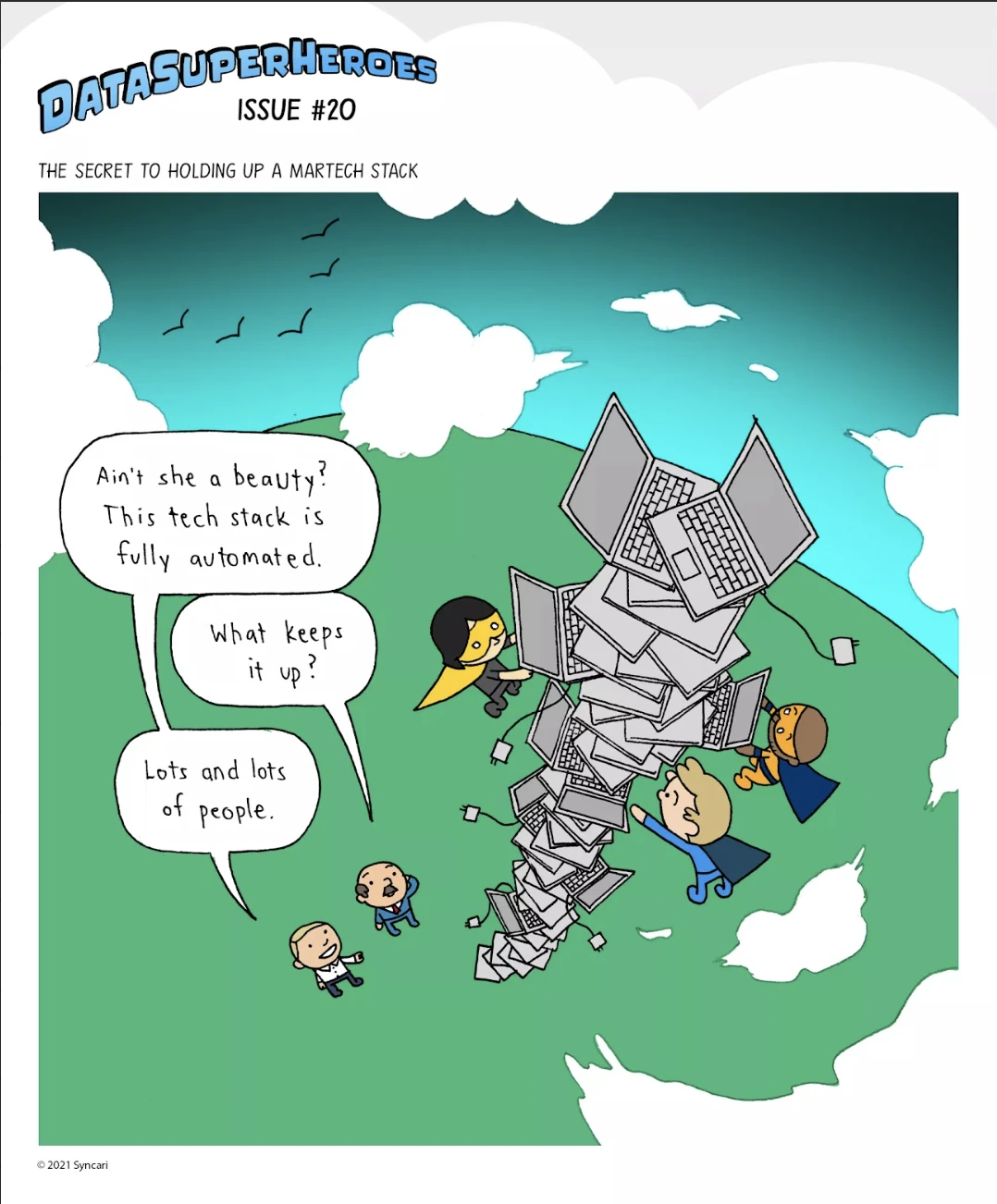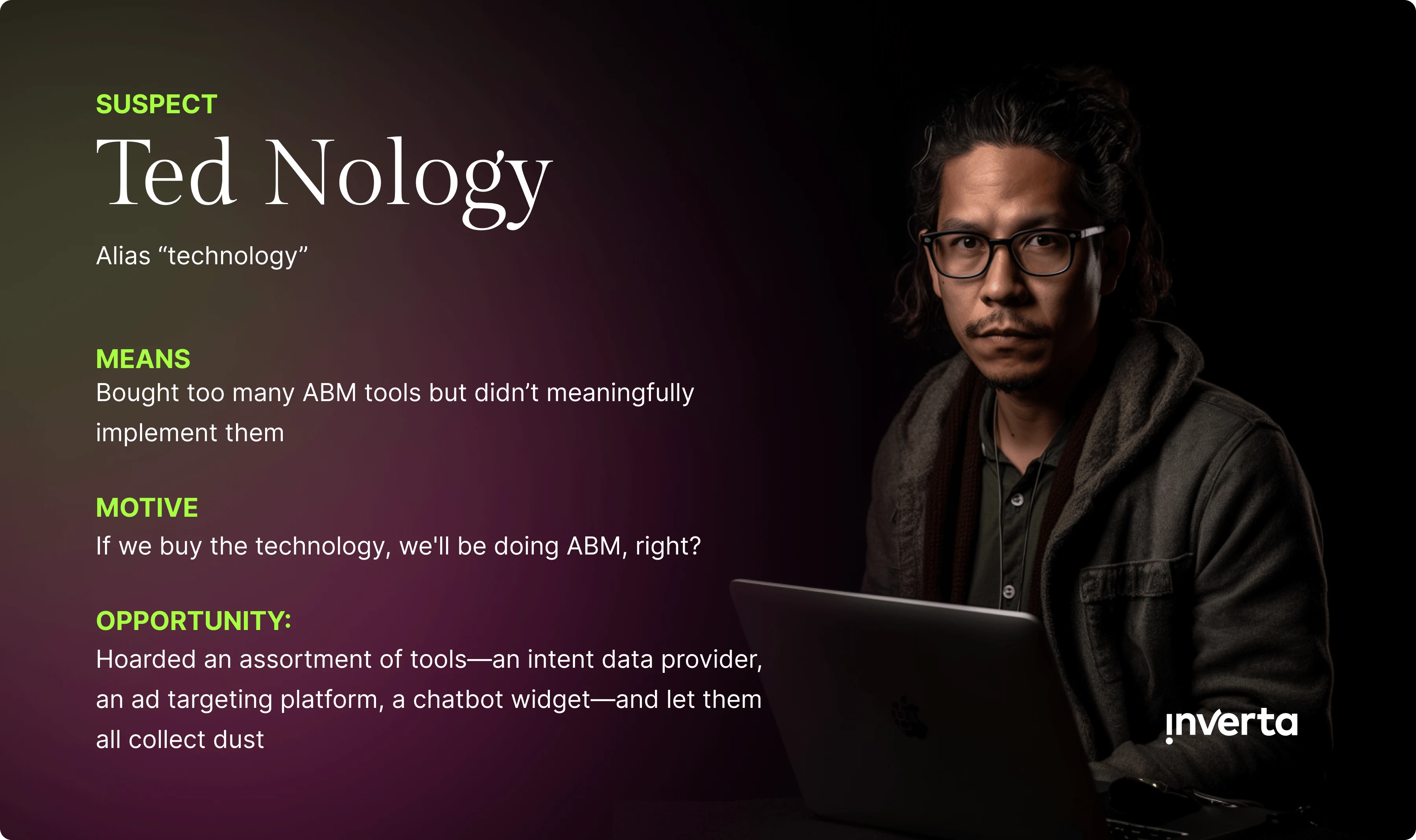His Dark Technologies

In our last episode, we finally tracked Trent Zishion back to the break room to find out what role they really played in ABM’s unfortunate disappearance. And while they were in the right place at the right time to influence their team into doing something unsavory, their real respect—and it seems—true affection for ABM, belies any accusations we might have.
It’s starting to feel like these twists and turns will never end. Every time we get close to solving this case, some new evidence appears, forcing us to re-examine everything we thought we knew.
Speaking of new evidence, it’s high time we pay a visit to the server room (how legacy!) to speak to our second-to-last suspect. Ted Nology (alias “Technology”) was disarmingly … polite.
This is his story.
The next clue: A crumpled map of 11,000 martech logos
Somewhere in the haze of the early 2010s, software spend took off. Sales teams who’d previously recorded leads in spiral-bound notebooks were suddenly managing half a dozen tools—the CRM, a sales outreach platform, a social media scheduling app, a calendaring app, email lookup tools, data verification tools, and the list went on.
And despite marketers feeling like they “didn’t have a seat at the table,” it was they who captured most of that spending power. They became cloud-tech titans and sequestered themselves in an ivory tower of tools.
By 2016 marketers were spending more on software than IT was on the rest of the company. Titles like “marketing technologist” and “technical marketer” grew common, and from this explosion of apps spilled new titles: sales operations, marketing operations, and then revenue operations. Companies were requiring Marketo, Eloqua, and Demandbase certifications in their job applications.
This spend hit a fever pitch with ABM software—Engagio roared onto the scene to compensate for how most CRMs were built—around the leads and contacts. They needed software to support their software. And this is where the wheels began to grow unmanageable.
Marketers were purchasing loads of software from vendors that were both cooperating and competing with each other (known as “coopetition”), and copied each other’s features. It grew difficult to figure out what each application did and it was terribly challenging for those marketers and their tech teams to figure out what was actually working.
Marketo, Engagio, Demandbase, 6Sense, and Terminus all had significantly overlapping features, hence, Marketo launched its own ABM feature and Engagio and Demandbase merged (now, just Demandbase).
In the data management realm, teams extracted and transformed all their data in customer data platforms and later, data lakes. They tried to enrich and expand it with everything from intent data to psychographics and the new category “technographics” to measure the site tags of all this software on other marketers’ websites. (How circular!)
At the height of the crisis, you had Demandbase, 6Sense, and Terminus all claiming to be the prodigal “ABM platform.” Many organizations were trying to turn ABM into a growth engine rather than just a tech stack project, but execution was messy.
The tech stacks grew so large people bragged about them on LinkedIn.

small superheroes holding up a giant, unstable pile of laptops.
After a time, it felt like the technology was driving the strategy—and it was. Marketers planned campaigns based on the constraints of their software rather than what buyers actually needed. For example, Facebook (now Meta) announced a developer platform for bots in 2016, which led to a chatbot craze that saw more than 100,000 bots created on Facebook Messenger. However, few teams asked themselves whether these bots were how their customers preferred to communicate with them. Due to poor adoption, these bots disappeared nearly as quickly as they’d come.
Somewhere in all that confusion, revenue teams lost sight of the buyer. Prospects grew more likely to receive a poorly targeted email because business development reps had all become their own mini email marketing teams, with everyone sending “Hi {firstname}” emails.
By 2016, 77% of buyers agreed: Buying had grown even more difficult. And most could be excused for not realizing an “account-based” revolution had taken place. They felt like the same old “marketing qualified lead” they always had.
Pictured is Gartner’s 2016 martech hype cycle. Many of these are still waiting to be realized.

This is why we tracked Ted Nology (alias “Technology”) back to the server room, hauntingly empty—the rows of humming servers reduced to just a few network-attached storage devices, and the rest of the space crammed with conference SWAG.
Ted met our eyes as we entered—a logoed stress ball in hand. Could he be the killer?
Let’s investigate.
Ted Nology’s alibi
“I know you think I did it,” Ted blurts as we enter.
We slow, return his gaze, and sit.
“It’s not a competition,” he goes on, growing animated. “I didn’t care who had a bigger software budget, just so you know. Just for the record.”
We pause. “Who said anything about budget?”
“You were about to. I know ABM and the marketing team surpassed us and her tools were really expensive but I was secretly fighting for her.”
We pull out a legal pad, lick a finger, and turn a page.
“ABM was actually a way to reduce the overall spend,” Ted cries, leaping up to a whiteboard covered in magnets and threads. “ABM comes into my company Conan Doyle Industries and asks me to audit the tech stack,” he says, circling and crossing vigorously. “I look into Demandbase and Drift and yeah, most seats were untouched; we were basically not using them. Drift, the SDRs weren’t checking the notifications and the wait time was half an hour. But I also realized we could use them to fix other problems.”
That kind of deep-dive—complete with stack readiness audits, integrations, and roadmaps—was exactly what most companies needed but few undertook.
Ted wheels another whiteboard over and flips to the backside; papers fly. “We turn off Drift. We cleaned up Demandbase by exporting and cross-referencing the lists. And we went back to the original …”he pins up a big map of the buyer’s journey“...diagram Brian Journey created and we built campaigns to matched that in Demandbase.”
“Nobody had done this?” we venture, but he cut us off.
“So now we’re looking at first-party data, engagement minutes, intent data—all used in approximately what funnel stages their buyers were in. And we’re asking, ‘How can we reduce this down to rules for ourselves?’ So we’re looking at whether we need three people to engage with the content before they count as showing intent, or 10 people. And we’re also adjusting for different ideal buyers.”
We can no longer write fast enough to keep up.
“Demandbase worked so well for Conan Doyle Industries that a big Fortune 500 prospect sent them a cease and desist letter. The personalized ads showed their logo, which directed them to a personalized landing page that also had the logo, and the legal team did not understand that only people from their company and IP address were seeing it. We got multiple reactions like that,” Ted cries, underlining that in red marker with a quick stabbing motion. “It was the right message, unignorable.”
Then Ted pauses and slows. “We won that business,” he said, eyes now distant. “I hadn’t been on a winning team like that before. People don’t think of IT as being part of that but we are.” He caps his marker. “People want more from work. I felt alive. That was real meaning.”
We both stare at the whiteboard slashed in stilettos of red marker.
“So. Which software did you kill?” we ask after a long pause.
“NOT ABM” Ted says with fire in his eyes.
So, did Ted Nology kill ABM?
Of all our characters, Ted certainly is suspect. Talking to others on the way out, there was a period after the ABM surge when a bunch of software contracts were canceled under mysterious circumstances—some that people noticed and complained about, and Ted brought them back. But everyone seemed to agree that when ABM was in, she was one of the few that Ted would leave the depths of his server room to visit.
If we had to guess, we’d say no. They say that true killers want to be found out. When fired up like Ted was, they slip and tell the truth. What slipped from Ted’s lips was a sense of admiration. And of loss.
There’s no saying for sure until we’ve checked off our final subject, next week—the infamous Mark Ketting.



